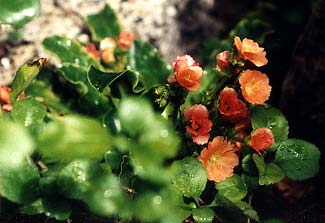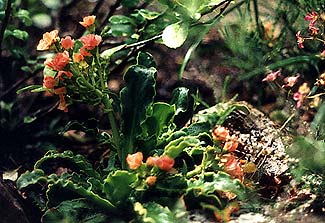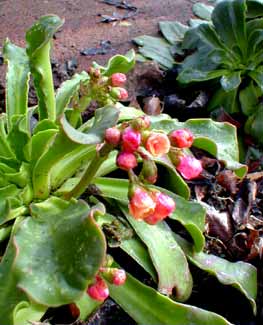 'Rondo' Lewisia or Cliff's Maids
'Rondo' Lewisia or Cliff's Maids
"Vanity, oh, vanity!
Young maids, beware of vanity!"
Grumbled out the buff-coat Bee,
Half parson-like, half soldierly.
-Helen Gray Cone
(1859-1934)
(1859-1934)
Most of our Lewisia cotyledon varieties are color variants without special names, but only color designations. This one however is a cultivar called 'Rondo,' introduced to gardening in 1989, but only recently made very widely available.
The color range can vary with seed-grown specimens, mainly from a dark pink-orange to a purer orange. Ours has the brightest orange flowers, showing up the usual pale flowers of wilder forms. Each of the many flowers is a bit frillier than a typical wild bloom, too, & lacks the stripe of so many normal forms.
 It has wavier leaves than for the usual lewisias, with rounder spatula-leaf tips, plus the flowers occur on shorter stems. The waviness of the leaves is a feature of a subspecies, L. c. howellii, which I suspect is part of its hybrid history. The chunky lopsided growth & short flower stems are not usual for lewisias, except sometimes for 'Rondo.' Variation in specific strains of lewisias are so broad that few definitive descriptions are possible, but for 'Rondo' the shorter stems, & flowers that lack stripes, are very typical.
It has wavier leaves than for the usual lewisias, with rounder spatula-leaf tips, plus the flowers occur on shorter stems. The waviness of the leaves is a feature of a subspecies, L. c. howellii, which I suspect is part of its hybrid history. The chunky lopsided growth & short flower stems are not usual for lewisias, except sometimes for 'Rondo.' Variation in specific strains of lewisias are so broad that few definitive descriptions are possible, but for 'Rondo' the shorter stems, & flowers that lack stripes, are very typical.It was originally planted in bright sun in an area that did not require watering, but the space over time became overgrown, & came to require watering for other things nearby. So I moved the Rondo to a roadside sun-garden where several Lewisias, including the extra-dark Siskiyou Pink, grow on a ledge where they all get the complete & radical drainage they require.
When I moved 'Rondo,' I was surprised to discover at that time that it had developed an enormous thick root underneath its little rosettes of leaves. Although I would never have the heart to dig mine up to eat, that thick root can in fact be peeled, blanched in salt water, then stir-fried with a mix of veggies to eat with noodles.
 Additionally, by summer's end the blooms turn into bland but edible small fruits. The First Peoples had uses for the whole plant, making a soothing medicinal tea from ground-up seeds, or boiling the root as a bitter potato-like delicacy.
Additionally, by summer's end the blooms turn into bland but edible small fruits. The First Peoples had uses for the whole plant, making a soothing medicinal tea from ground-up seeds, or boiling the root as a bitter potato-like delicacy.The first two pictures on this page are of Rondo in May 2002, before it was moved. You will note it does not have the fountaining stems of other "regular" Lewisias, but produces stubbier panicals.
The third photo shows 'Rondo' in the better location, with the first flower buds erupting about the third week in February (2004). Its buds don't usually show color quite this soon, & the rest of the lewisias along the ledge won't begin for a couple weeks or longer.
When fertilizing nearby shrubs & perennial bulbs, I try to avoid giving any of the lewisias any feed, as they don't need much. Perfect drainage is a must for their good health, but they can otherwise stand full sun to partial shade, with a preference for a small portion of shade in the hottest summer afternoons.
If they are in a great deal of sun they can still do very well if the succulent leaves are poking up & out from between rocks, as the rocks will protect the thick root which does not like to be hot.
Lewisia cotyledon Bright Yellow